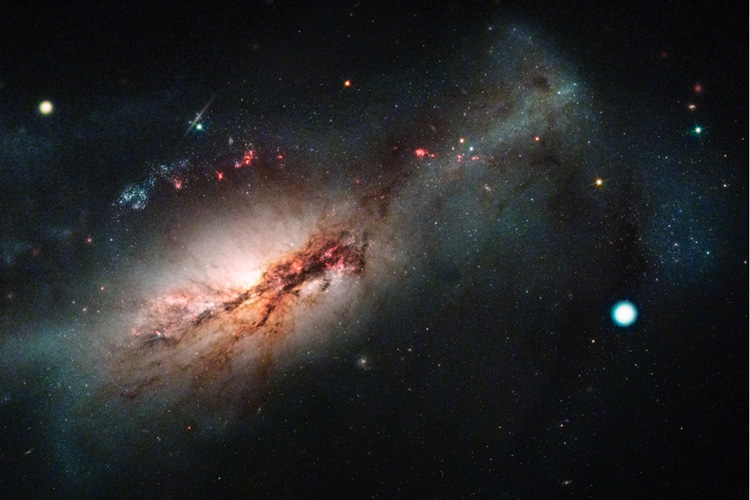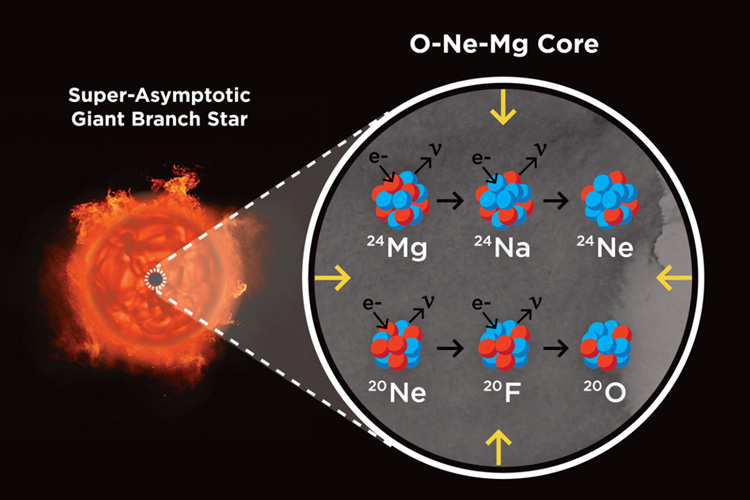Stellar explosion in 1054 C.E. may have been a third flavor of supernova

Astronomers have found convincing evidence that supernovae come in a third flavor, powered by a long-suspected explosive mechanism that may explain a bright supernova humans observed 1,000 ago and that birthed the beautiful Crab Nebula.
The evidence is an exploding star observed in 2018, the first that fits all six criteria for a hypothesized type of supernova called an electron-capture supernova.
Large stars — red supergiants bigger than about 10 of our suns — collapse in the center when their cores run out of fuel, causing the outer layers to explode and leaving behind a neutron star or black hole. Stars less massive than about eight of our suns and that have a companion star likely contract initially to a white dwarf, which then pulls matter onto itself from the adjacent star until it experiences a runaway thermonuclear explosion that blows it to smithereens.
Stars between 8 and 10 solar masses theoretically should explode in a different way. Their immense internal pressure would force electrons to fuse with atomic nuclei, causing a sudden drop in electron pressure that precipitates a collapse and subsequent explosion of the surrounding layers. What’s left behind would be a neutron star a bit more massive than our sun.
The 2018 supernova, called SN 2018zd, and its progenitor star, respectively, match the profile of an electron-capture supernova and the type of massive star that would undergo such an explosion. The bright supernova observed around the world in 1054 C.E., which was visible during the day for 23 days, had characteristics reminiscent of SN 2018zd — in particular, a very long-lasting glow that made it visible at night for nearly two years — suggesting that it, too, was an electron-capture supernova.
“This is the best known case for this interesting category of supernovae that is in between the mass range for the exploding white dwarf and the iron core of a massive star that collapses and then rebounds and leads to an explosion, the so-called core-collapse supernovae,” said Alex Filippenko, a professor of astronomy at the University of California, Berkeley. “This study significantly increases our understanding of the final stages of stellar evolution.”
Filippenko and a team of astronomers led by Daichi Hiramatsu, a graduate student at UC Santa Barbara and Las Cumbres Observatory (LCO), a worldwide network of robotic optical telescopes, reported the findings today in the journal Nature Astronomy. They are members of the Global Supernova Project, a worldwide team of scientists that uses dozens of telescopes on Earth and in space to observe supernovae.
“The term Rosetta Stone is used too often as an analogy when we find a new astrophysical object, but in this case, I think it is fitting. This supernova is literally helping us decode thousand-year-old records from cultures all over the world,” said Andrew Howell, a staff scientist at LCO, adjunct professor of physics at UC Santa Barbara and leader of the Global Supernova Project. “In the process, it is teaching us about fundamental physics — how some neutron stars get made, how extreme stars live and die, and about how the elements we’re made of get created and scattered around the universe.”
Amateur astronomer’s discovery
Shortly after the supernova was noticed by amateur astronomer Koichi Itagaki in Japan, team member Schuyler Van Dyk, Filippenko’s former postdoctoral fellow and a senior research scientist at the California Institute of Technology, was able to obtain a Hubble Space Telescope image of the supernova. He compared this with earlier Hubble Space Telescope images of that area of the sky and positively identified the progenitor star in the galaxy NGC 2146, about 31 million light years from Earth.

“It’s great when we have both pre-explosion and post-explosion Hubble images, because we can confidently pinpoint which star exploded from the exact location of the supernova,” Van Dyk said.
“That was one of the key components that had never been done for other candidate electron-capture supernovae — they had never had a viable identified progenitor star, the star that explodes,” Filippenko said.
The identity of the progenitor star allowed the team to compare both the star and supernova characteristics with those predicted by team member Ken’ichi Nomoto of the Kavli Institute for the Physics and Mathematics of the Universe, at the University of Tokyo. He first hypothesized this type of supernova in 1980.
Based on models by Nomoto and other astronomers, such stars should have a lot of mass — between 8 and 10 solar masses — but lose much of it before exploding, and this shed mass should be of an unusual chemical composition, rich in helium, carbon and nitrogen, but low in oxygen. The electron-capture supernova explosion should be weak, about 10 times less energetic than a core-collapse supernova; have little radioactive fallout, primarily radioactive nickel; and have lots of neutron-rich elements, such as oxygen, neon and magnesium, in the core.
That is what they found. The progenitor star was a massive super-asymptotic, giant branch (SAGB) star — that is, an old, bloated red giant, the largest diameter star possible. Observations showed that it had shed a significant fraction of its mass before the explosion, and the gas surrounding the pre-explosion star matched the expected chemical composition. The explosion was relatively weak for a Type II supernova, produced little radioactive nickel, and showed strong emission lines of a neutron-rich element, stable nickel.
The brightening and dimming of the supernova over time resembled that of several other unusual supernovae that have been categorized as Type II-P because their light output first plateaus and then drops to a very low level about 100 days after the explosion. This faintness is due to the dearth of radioactive nickel.
The new discoveries shed light on some mysteries of the 1054 C.E. supernova, which exploded within the Milky Way Galaxy and was famously mentioned in Chinese and Japanese records. The resulting remnant — the Crab Nebula — has been studied in great detail, and the supernova has been the best candidate for an electron-capture supernova. The new result increases the confidence that SN 1054 was an electron-capture supernova, the team argues.
This hypothesis also explains why that supernova was relatively bright, compared to expectations based on early models of electron-capture supernovae: Its luminosity was probably artificially enhanced by the supernova ejecta colliding with material cast off by the progenitor star, as was seen in SN 2018zd.
“People have speculated that the Crab Nebula supernova was an electron-capture supernova, but I think SN 2018zd makes that association stronger,” Filippenko said. “We have now come to the realization that an electron-capture supernova may make itself more noticeable for a longer time than would have been anticipated just based on the initial theory 40 years ago.”
Filippenko and the team hope to find more examples of this third flavor of supernova that need to be relatively nearby for astronomers to be able to identify each one’s progenitor star, which is typically faint, and record the long-term glow from the ejecta.
RELATED INFORMATION
- The electron-capture origin of supernova 2018zd (Nature Astronomy)
- Alex Filippenko’s website
